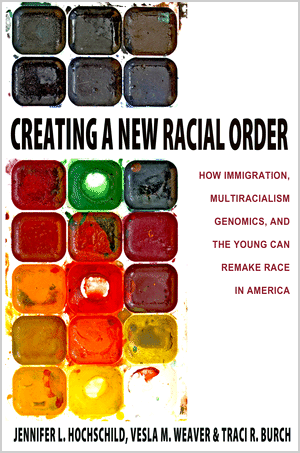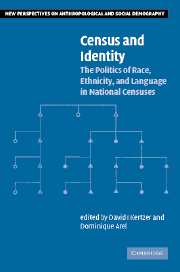Creating a New Racial Order: How Immigration, Multiracialism, Genomics, and the Young Can Remake Race in America
Princeton University Press
March 2012
282 pages
6 x 9; 17 halftones. 14 line illus. 10 tables
Cloth ISBN: 9780691152998
eBook ISBN: 9781400841943
Jennifer L. Hochschild, Henry LaBarre Jayne Professor of Government and Professor of African and African American Studies
Harvard University
Vesla M. Weaver, Assistant Professor
The Woodrow Wilson Department of Politics
University of Virginia
Traci R. Burch, Assistant Professor of Political Science
Northwestern University

The American racial order—the beliefs, institutions, and practices that organize relationships among the nation’s races and ethnicities—is undergoing its greatest transformation since the 1960s. Creating a New Racial Order takes a groundbreaking look at the reasons behind this dramatic change, and considers how different groups of Americans are being affected. Through revealing narrative and striking research, the authors show that the personal and political choices of Americans will be critical to how, and how much, racial hierarchy is redefined in decades to come.
The authors outline the components that make up a racial order and examine the specific mechanisms influencing group dynamics in the United States: immigration, multiracialism, genomic science, and generational change. Cumulatively, these mechanisms increase heterogeneity within each racial or ethnic group, and decrease the distance separating groups from each other. The authors show that individuals are moving across group boundaries, that genomic science is challenging the whole concept of race, and that economic variation within groups is increasing. Above all, young adults understand and practice race differently from their elders: their formative memories are 9/11, Hurricane Katrina, and Obama’s election—not civil rights marches, riots, or the early stages of immigration. Blockages could stymie or distort these changes, however, so the authors point to essential policy and political choices.
Portraying a vision, not of a postracial America, but of a different racial America, Creating a New Racial Order examines how the structures of race and ethnicity are altering a nation.
Contents
- List of Figures and Tables
- Introduction
- PART I: THE ARGUMENT
- 1. Destabilizing the American Racial Order
- PART II: CREATING A NEW ORDER
- 2. Immigration
- 3. Multiracialism
- 4. Genomics
- 5. Cohort Change
- 6. Blockages to Racial Transformation
- PART III: POSSIBILITIES
- 7. The Future of the American Racial Order
- Notes
- References
- Index
Introduction
A racial order—the set of beliefs, assumptions, rules, and practices that shape the way in which groups in a given society are connected with one another—may seem fixed. Racial orders do change, however. The change may be gradual, as when America evolved over two centuries from being a society with slaves to a slave society, or cataclysmic as when slavery or serfdom is abolished or apartheid instituted. A racial order can change for some groups but not others; the Immigration Act of 1924 denied all Asians and most Kuropcans and Africans, but not Latin Americans, the right of entry to the United States. Change in a racial order is most visible when it results from severe struggle, but it may also occur unintentionally through thousands of cumulative small acts and thoughts. And a racial order can change in some but not all dimensions; American Indians gained U.S. citizenship in 1924 but few have reacquired the land lost through centuries of conquest and appropriation.
Variation in pace, direction, activity, and object makes it difficult to see major change while it is occurring. Nevertheless, we argue that the racial order of the late twentieth century that emerged from the 1960’s civil rights movement, opening of immigration, and Great Society is undergoing a cumulative, wide-ranging, partly unintentional and partly deliberate transformation. The transformation is occurring in locations and laws, beliefs and practices. Its starting point was the abolition of institutional supports and public commitments of the pre-1960s racial order, such as intermarriage bans, legally mandated segregation, unembarrassed racism, and racial or ethnic discrimination. Once those props were removed, the changes broadly signaled by “the 1960s” could develop over the next forty years. They included a rise in immigration, Blacks’ assertion of pride and dignity, Whites’ rejection of racial supremacy (at least in public), a slow opening of schools, jobs, and suburbs to people previously excluded, and a shift in government policy from promoting segregation and hierarchy and restricting interracial unions to promoting (at least officially) integration and equality and allowing interracial unions.
As a consequence, in the first decade of the twenty-first century, new institutions and practices have been moving into place: official records permit people to identify with more than one race, anti-discrimination policies are well established in schools and workplaces, and some non-Whites hold influential political positions. At the same time, the late twentieth century’s understanding of the very meaning of race—a few exhaustive and mutually exclusive groups—is becoming less and less tenable as a consequence of new multiracial identities, immigrants’ rejection of conventional American categories, and genomic science. Social relations, particularly among young Americans, are less driven by stereotypes, more fluid and fragmented, and more susceptible to creation rather than acquiescence. Even deeply seated hierarchies of income, educational attainment and achievement, prestige, and political power are easing for some groups and in some dimensions of life. Race or ethnicity, though still important, is less likely to predict a young person’s life chances than at any previous point in American history; today’s young adults will move through adulthood with the knowledge that one need not be White in order to become the most powerful person in the world…
…Thus the late twentieth-century racial order captures less and less of the way in which race and ethnicity are practiced in the United States today and may be practiced in the foreseeable future. If transformative forces persist and prevail, the United States can finally move toward becoming the society that James Madison envisioned in Federalist #10, one in which no majority faction, not even native-born European Americans, dominates the political, economic, or social arena.
The Madisonian vision must not blind us to two concerns. If it persists, creation of a new racial order will not have only beneficial results. Some Americans are likely to be harmed by these changes and will thereby suffer relative or even absolute losses. Continuing the venerable American pattern, they will be disproportionately African American or Native American, supplemented by undocumented immigrants. All Americans are likely to lose some of the joys and advantages of a strong sense of group identity and rootedness. The greater concern, however, is that the newly created racial order will not persist and prevail. Black poverty and alienation may be too deep; White supremacy may be too tenacious; institutional change may be too shallow; undocumented immigrants may not attain a path to belonging; genomic research may usher in a new era of eugenic discrimination. In short, Americans may in the end lack the political will to finish what demographic change, scientific research, young adults’ worldviews, and the momentum of the past decade have
started…
…Our exploration of transformative forces and their blockages is spread over three parts and seven chapters. Part 1, “The Argument,” has one chapter. Chapter 1 explicates the five components of a societal racial order and suggests what is at stake in the ongoing reinvention of the American racial order. Examples show how immigration, multiracialism, genomics, and cohort change are transforming each component of the late twentieth-century racial order. Chapter 1 also points to elements of American society that could distort or block transformation of the racial order. Perhaps most important, it provides analytic justification for our expectation that creative forces will outweigh blockages, so long as Americans take steps to incorporate those now in danger of exclusion and to improve the life chances of those at the bottom.
Part 2, “Creating a New Order,” consists of five chapters. Chapters 2 through 5 respectively analyze immigration, multiracialism, genomics, and cohort change, in each case using the five components of a racial order to organize the discussion. Despite variation in the content and process of change, a consistent pattern emerges: each transformative force independently (and all of them interactively) is changing how Americans understand what a race is, how individuals are classified, how groups are relatively positioned, how state actions affect people’s freedom of choice, and how people relate to one another in the society. Chapter 6 looks at the opposite side of the creative dynamic—that is, features of the American racial order that reinforce the late twentieth-century order of clear racial and ethnic boundaries, relatively fixed group positions, intermittently prohibitive state actions, and hostile social relations. Chapter 6 focuses on four issues that directly challenge the transformative forces—the costs of a loss in group identity, wealth disparities, unprecedented levels of Black and Latino incarceration, and the possibility that illegal immigrants or Muslims might become the new pariah group. It warns that effective creation of a new racial order can itself deepen the disadvantage of the worst off even while moving toward a more racially inclusive polity.
Finally, part 3, “Possibilities,” consists of one chapter. Chapter 7 concludes by considering the likelihood that the current American racial order will look very different by the time our children reach old age. It also sketches some political and policy directions necessary to promote transformation, expand its benefits, and reduce the proportion of Americans who arc left out or harmed…


